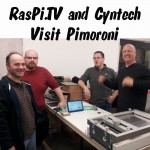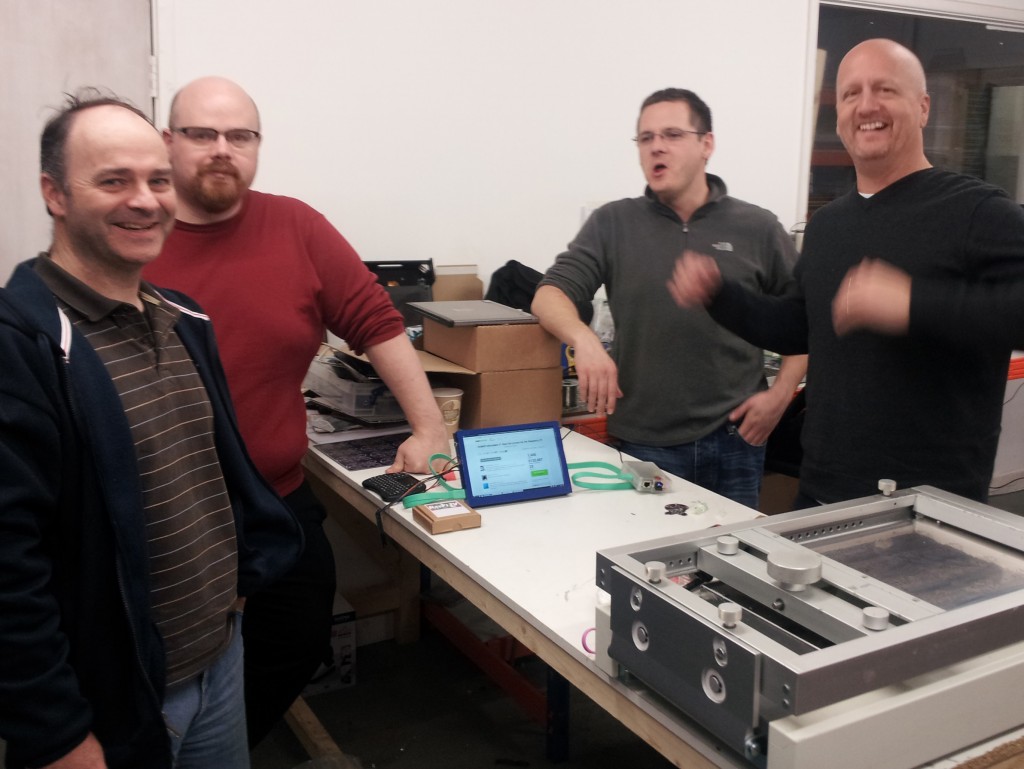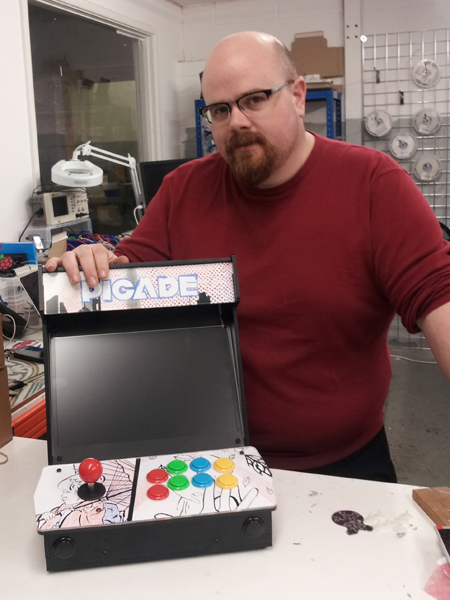
Yesterday, Dave Mellor and I went to visit Paul and Jon at Pimoroni. One of the main things we wanted to do was discuss the case/surround design of our HDMIPi screen Kickstarter project with the guys.
So we showed Paul and Jon the V1 prototype in action and left a V2 LCD screen with Paul for the mechanical design. We hope to be able to show some designs or sketches in due course. We actually shot some of our Kickstarter video at Pimoroni. The pick and place machine in the video is the one that assembles the PiHub and the PiGlow and it’ll be used to make all the other good stuff they’ve got planned.
Gee Bartlett, the hard-working, bearded chap in the KS video, who operates the pick and place machine on a day-to-day basis, was also there working on some wiring looms for Picade. Picade was Pimoroni’s Kickstarter from last year. We found out that they launched theirs on 31st October too. That was a weird coincidence.
Gee also took this photo for us with my phone (thanks Gee). At least Jon’s still got most of his hair but he doesn’t usually have a twisted mouth like that. Dave looks like he’s conducting the orchestra…
The large metal device bottom-right is the jig that Gee uses when applying solder paste to PCBs before they go in the pick and place machine. The 9 inch affordable Hi-Def HDMI screen in the home-made case (depron and balsa with pro-film covering) is the HDMIPi V1 prototype displaying the current state of its own KickStarter campaign.
It was the third time I’d been to Pimoroni, but the previous two visits had been a bit hectic. Last time was when we did the video shoot with Oxyfire. It was really nice to have a really good chat with both Jon and Paul. Paul and I share a hobby in RC flying. Although I haven’t flown much in the last couple of years, my various Pi projects appreciate my stock of lipos for portable power.
Paul showed me the Picade
While Jon and Dave were busy with something else, Paul showed me the final version of Picade, which looks great.
Radio Lollipop – looks amazing.
You may have seen the Radio Lollipop wifi radio on the Raspberry Pi front page a couple of weeks ago. We saw the prototypes for that, and all I can say is they look a thousand times better than the photos. The photos look good, but the real thing looks amazing. Dave wanted to eat it. I didn’t take any photos of it as I couldn’t do it justice with a phone.
Finished with a Pub Visit
We knew that Paul and Jon were geniuses, but they’ve placed their workshop 200 yards from an excellent pub, where the barman talks about software and hardware hacking. We concluded our meeting there. It was a nice way to end the day. I’m looking forward to seeing what Paul comes up with for the HDMIPi case design.


Haha, I like it! But maybe it’ll need a bigger screen soon to fit all the numbers on ;-)
Actually, it’s in forced 1280×800 mode to make things a nice size, but if you force 1920×1080 from the Pi it’ll probably scale everything down to fit larger numbers on. (But then icons etc are a bit smaller).
So if you only wanted to show small numbers, could you force the Pi to set resolution 640×480 and then the screen would automagically scale it up?
That would work if there is a 640×480 HDMI mode (or I suppose you might be able to resize the framebuffer?).
http://www.elinux.org/RPi_Configuration#Video_mode_options
HTH ;-)